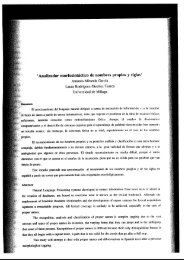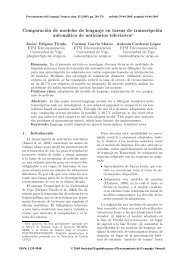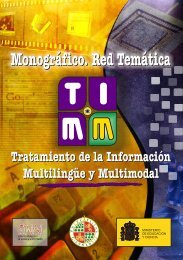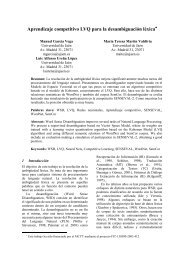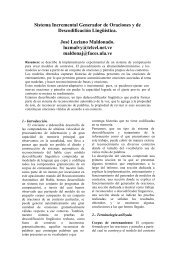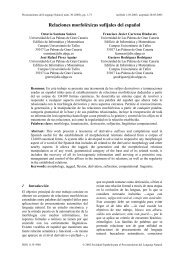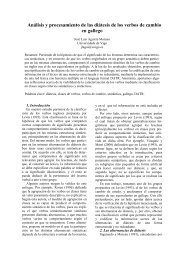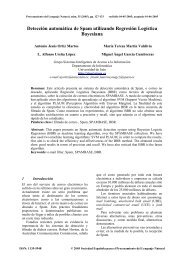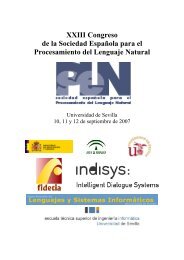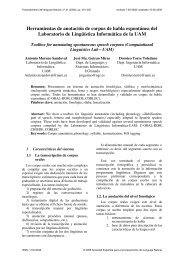A Machine Learning Approach for Factoid Question Answering - sepln
A Machine Learning Approach for Factoid Question Answering - sepln
A Machine Learning Approach for Factoid Question Answering - sepln
Create successful ePaper yourself
Turn your PDF publications into a flip-book with our unique Google optimized e-Paper software.
Model 1 Model 2<br />
Algorithm Entity Long Entity Long<br />
Answer Answer<br />
Maximum<br />
Entropy 0.33 0.52 0.34 0.53<br />
AdaBoost 0.31 0.47 0.32 0.47<br />
SVM<br />
(best kernel) 0.21 0.36 0.25 0.42<br />
(Pa¸sca, 2003) 0.37 0.52 – –<br />
Table 3: Summary of MRR results <strong>for</strong> the<br />
different ML algorithms. The (Pa¸sca, 2003)<br />
row shows results <strong>for</strong> our system using the<br />
expert-designed answer ranking <strong>for</strong>mula. QP<br />
classifies correctly all questions.<br />
Model 1 Model 2<br />
Algorithm Entity Long Entity Long<br />
Maximum<br />
Answer Answer<br />
Entropy 0.29 0.43 0.31 0.47<br />
AdaBoost<br />
SVM<br />
0.29 0.43 0.30 0.44<br />
(best kernel) 0.20 0.32 0.22 0.39<br />
(Pa¸sca, 2003) 0.33 0.47 – –<br />
Table 4: Summary of MRR results <strong>for</strong> the<br />
different ML algorithms. The (Pa¸sca, 2003)<br />
row shows results <strong>for</strong> our system using the<br />
expert-designed answer ranking <strong>for</strong>mula. All<br />
experiments are evaluated <strong>for</strong> the complete<br />
QA system.<br />
More precision may be obtained too, with an<br />
extended feature set and more training examples.<br />
4 Discussion and Conclusions<br />
We have built a robust QA system with very<br />
low NLP requirements and a good precision.<br />
We just need a POS tagger, a shallow<br />
chunker, a NERC and some world knowledge<br />
(NERC and QP gazetteers). Fewer resources<br />
make the system easier to be modified<br />
<strong>for</strong> different environments. Low resource<br />
requirements also mean fewer processing cycles.<br />
This is a major advantage when building<br />
real-time QA systems.<br />
We have implemented both <strong>Question</strong> Processing<br />
and Answer Extraction using machine<br />
learning classifiers with rich feature<br />
sets. Even though, in our experiments per<strong>for</strong>mance<br />
is not increased above the state<br />
of the art, results are similar and several<br />
benefits arise from this solution. (a) It is<br />
now easy to include new Answer Ranking<br />
and <strong>Question</strong> Processing features. (b) <strong>Machine</strong><br />
learning can be retrained <strong>for</strong> new doc-<br />
David Dominguez-Sal and Mihai Surdeanu<br />
136<br />
ument styles/languages/registers easier than<br />
reweighting expert-developed heuristics. (c)<br />
We can decide if an answer is more probable<br />
to be correct. For instance, the heuristicbased<br />
system of (Pa¸sca, 2003) builds a complex<br />
<strong>for</strong>mula that allows us to compare (and<br />
sort) candidate answers from a single question.<br />
But an absolute confidence in the answer<br />
appropriateness is not available: <strong>for</strong><br />
example, a candidate answer can score 100<br />
points but depending on the question it can<br />
be a correct answer (and be the first of ranking)<br />
or a wrong answer (and be in last positions<br />
of the ranking). Our machine learning<br />
method is not limited to sorting the answers<br />
but it can give us a confidence of how good an<br />
answer is. This is very useful <strong>for</strong> an user interface<br />
where incorrect results can be filtered<br />
out and the confidence in the displayed answers<br />
can be shown beside the actual answer<br />
text.<br />
References<br />
Li, X. and D. Roth. 2002. <strong>Learning</strong> <strong>Question</strong><br />
Classifiers. Proceedings of the 19th International<br />
Conference on Computational<br />
Linguistics (COLING), pages 556–562.<br />
Lin, D. 2006. Proximity-based Thesaurus.<br />
http://www.cs.ualberta.ca/ lindek/downloads.htm.<br />
Pa¸sca, M. 2003. Open-Domain <strong>Question</strong><br />
<strong>Answering</strong> from Large Text Collections.<br />
CSLI Publications.<br />
Sang, Erik F. Tjong Kim and Fien De Meulder.<br />
2003. Introduction to the CoNLL-<br />
2003 Shared Task: Language-Independent<br />
Named Entity Recognition. Proceedings<br />
of CoNLL-2003, pages 142–147.<br />
Surdeanu, M., J. Turmo, and E. Comelles.<br />
2005. Named entity recognition from<br />
spontaneous open-domain speech.<br />
Interspeech-2005.



